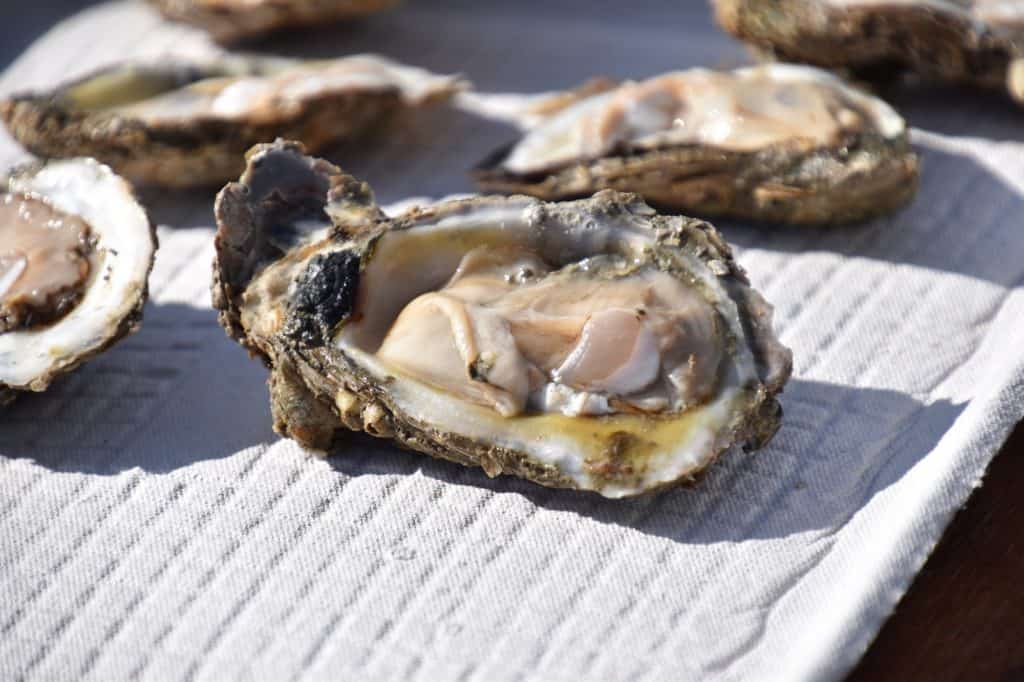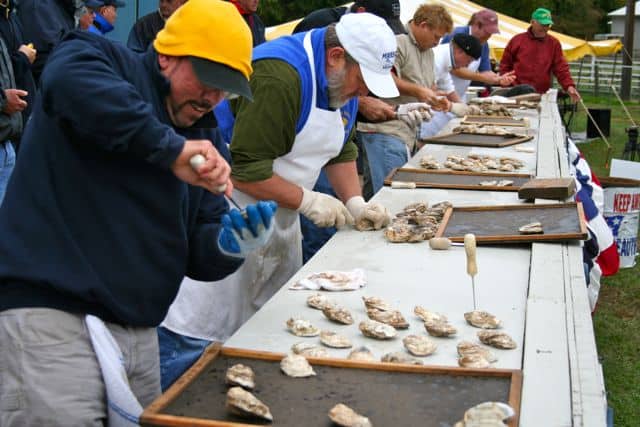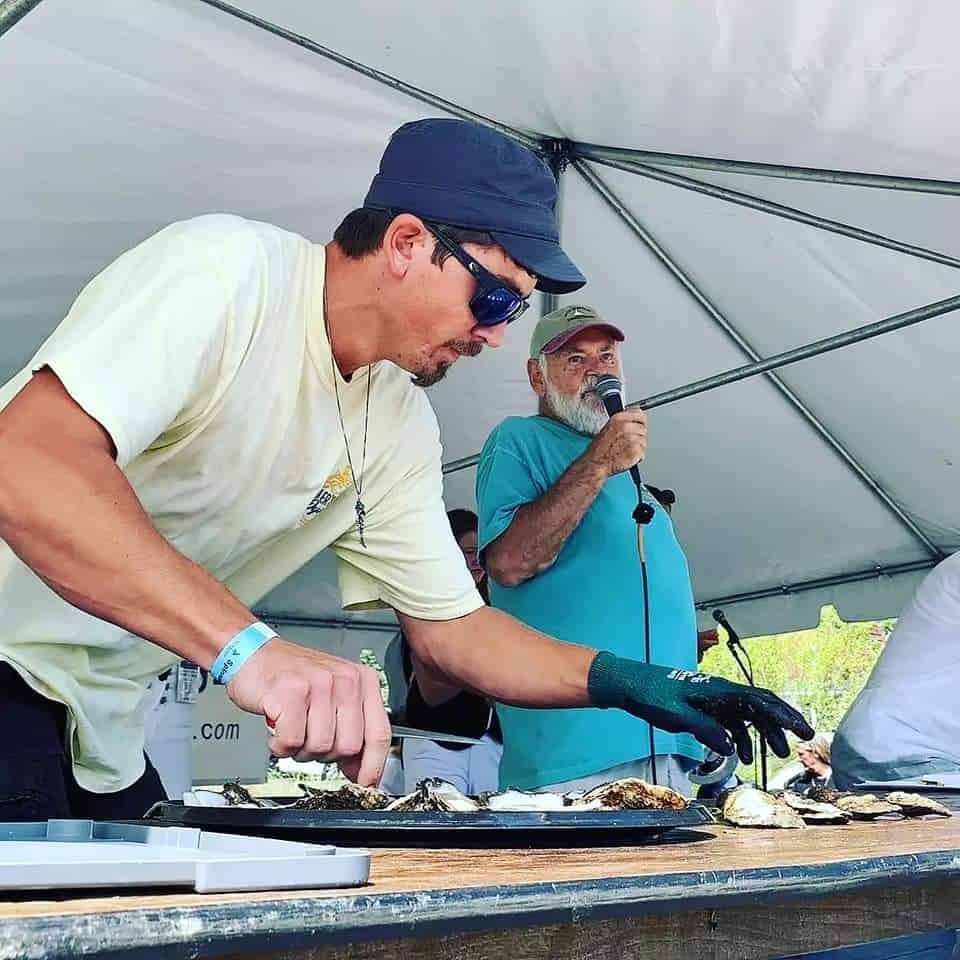Aw Shucks:

Oyster Season is Here
By Molly Weeks Crumbley
October has arrived in Maryland, bringing hayrides, corn mazes, pumpkin spice everything, and … oysters. Yes, oysters. With recreational and commercial oyster harvesting in Maryland now open until March 31, communities all over the Chesapeake Bay area are ready to celebrate oyster season.
Why all the fuss over a mere mollusk? Oysters are worthy of our appreciation, even from those who don’t eat seafood. They are a critical piece of the local ecosystem that the Chesapeake Bay Foundation classifies as a keystone species. “The reefs that oysters form provide important habitat for the Bay’s fish, crabs, worms, and other animals. Oysters are also prolific filter feeders that remove light-blocking algae from Bay waters and help remove excess nutrients like nitrogen and phosphorus,” CBF explains. “In other words, more oysters equal better water quality.”
While large-scale projects to restore reefs are underway with help from government and conservation organizations, the average Marylander can play a role just by taking small steps. The CBF suggests supporting restaurants that participate in their oyster shell recycling program, shopping at local oyster farms, and volunteering to clean shells or make reef balls. Some locals are even becoming homegrown oyster gardeners. Anyone with adequate water access on their property can become an oyster gardener by attending a workshop with the CBF, where they receive instructions and supplies to tend their oyster spats over nine months. Once the oysters have reached adult size, they are then moved to nearby sanctuary reefs where they can help be part of the reef rebuilding process.
In addition to the ecological benefits that oyster reefs can provide, the Chesapeake Bay Program also notes that oyster reefs have had historical and economic impacts in the region. “Since the late 19th century, the oyster industry—including the catch, sale, shucking, packing and shipping of oysters—has contributed millions of dollars to the region’s economy. Oysters have also added to the region’s historical and cultural heritage, inspiring the unique design of the skipjack and fueling countless bull and oyster roasts.”
Today, oyster harvesting still plays an important role to the watermen who earn their living providing catches for the seafood market. Many still rely on traditional harvesting methods like hand or patent tonging, keeping that piece of Maryland history alive and well. Even the Smithsonian Museum of American History maintains artifacts and information related to the oyster trade. As their online exhibits attest, “Scratch the surface of places like Crisfield, Cambridge, Oxford, St. Michaels, Galesville, Solomons, or Smith Island, Md., and you’ll find a heritage in oysters. No church supper, community festival, or Thanksgiving feast was complete without oysters—stewed, fried, steamed, raw, or baked into a pie.”
Speaking of festivals, several celebrating the oyster are popping up around Maryland this month. First up is the 24th Captain Avery Museum Oyster Festival on Saturday, Oct. 16. Taking place on the museum grounds in Shady Side, the festival promises to be a family-friendly event. Museum director Deborah Gangloff says that attendees can expect to find “oysters, events for the kiddies, oysters, music, crafts, oysters, food from local restaurants, beer and coffee, oysters, and oysters.”
Did she mention that there will be oysters? There will be, in all sorts of forms: fried, stewed, raw, and in shooters. After having to cancel last year’s festival, Gangloff is “thrilled to be back in form this year.” Their festival is the museum’s biggest fundraiser each year, helping to raise money for cultural events and programs to benefit the community. Captain Salem Avery, who owned the property in the 1860s, was himself an oysterman, earning his living harvesting on the Bay. The Oyster Festival hearkens back to his livelihood and celebrates the rich traditions surrounding the humble bivalve.
“Oysters are amazing creatures,” Gangloff says, “not the least because of their filtering abilities. The original populations before settlement could filter the Bay in a day. Our current population can do it in a year.” To help stress this point and educate the public about the importance of sustaining oyster populations, representatives from the Oyster Restoration Project will be set up at the festival and all shells will be recycled. In addition, attendees will have the opportunity to tour the museum’s rain gardens for demonstrations of how native plants on land can mimic an oyster’s filtration and improve the quality of the water that runs off into the Bay. “We like to practice what we preach,” explains Gangloff. “Oysters are so important in Maryland.”

The Shucking Scene
Reigning American oyster shucking champion Honor Allen may call Florida home, but he too has a great appreciation of the Maryland oyster scene.
“The oyster history in Maryland is absolutely amazing! I love reading about what Maryland used to produce hundreds of years ago and the efforts they’re doing now to restore the natural beds. There’s so much to learn about oysters; a whole world out there that most people have no idea about.”
One of the unique components of that world is, undoubtedly, competitive oyster shucking, a spectacle that can be seen this weekend at the 55th annual U.S. Oyster Festival in Leonardtown. Allen will be competing again in hopes of earning his fourth national victory, going up against 28 other competitors from all over the country.
For those new to the world of competitive oyster shucking, Allen provides a brief overview. The shucking is a timed event in which each competitor is presented with 24 whole oysters to open. After their initial time is recorded, each oyster then gets analyzed by a team of judges who “add penalty seconds to your flat time for every impurity they find, like bits of shell left on the oyster meat, oyster still attached to the bottom shell, and so on. Whoever has the lowest final time wins!”
Former national champion George Hastings, of Maryland, agrees, adding that presentation can be just as important as speed in the competitions. “Speed is only part of it. Presentation should be as perfect as what gets served in a fine dining establishment,” he explains. “I practice every time I shuck an oyster.” After judging, the overall winner is declared and the oysters get shared among the enthusiastic crowd of onlookers.
Both Allen and Hastings have earned champion status and gone on to defend their titles at the Galway Ireland International Oyster Opening Contest in past years. Neither shucker has plans to throw in the towel any time soon, and both will compete at the U.S. Oyster Festival this weekend.

“I still compete because there is a family-like bond between the shuckers from around the country and we can be with the best in the trade to share means and methods and a few yarns,” Hastings says. “The festival is a great family friendly weekend in beautiful Southern Maryland with good food, good drink, and oysters any way you like them!”
Family friendly is right; Hastings’s son has followed in his footsteps and competes in shucking competitions as well. Last year’s U.S. Oyster Festival shucking competition was virtual, but this year promises normal operations with except for a mask requirement when in indoor spaces.
Karen E. Stone, administrator of the U.S. Oyster Festival, reports that 29 shuckers will be competing this year, as well as nine competitors in the annual oyster cook-off (where editor emeritus Sandra Olivetti Martin will judge, along with Baltimore chef John Shields and chef Gwyn Novak from No Thyme to Cook). “We are in for a great show on both fronts!” she enthuses. In addition to the competitions, there will be local food and drinks, live music, arts and crafts, local vendors, and other entertainment. “Many things will look familiar but there are always new things to eat, experience, enjoy, and explore!”
Still can’t get enough of oysters? Later this month, half-shell enthusiasts can head across the Bay to St. Michaels for OysterFest on October 30. At the Chesapeake Bay Maritime Museum, attendees can expect to “sip, slurp, and savor” as they check out all on offer. One highlight each year is the oyster stew cook off, in which local chefs and restaurants are judged in a blind taste test. The first 500 to the contest get to sample the savory stews and help crown a People’s Choice winner. Unique to OysterFest are the opportunities to take scenic river cruises, sign up for an oyster slurping competition, and even try your hand at traditional oyster tonging. Like the Captain Avery Museum, the Chesapeake Bay Maritime Museum is also invested in stewardship and conservation, “dedicated to preserving and exploring the history, environment, and culture of the entire Chesapeake Bay region, and making this resource available to all.”
Whether you eat them, grow them, harvest them, shuck them, or just appreciate their water-cleaning prowess, Eastern oysters have clear impacts on Marylanders across the state. How will you celebrate those half-shell heroes this month?
Upcoming Festivals:
U.S. Oyster Fest
Oct. 16 & 17 (Sa 10am-6pm, Su 11am-6pm)
St. Mary’s County Fairgrounds, Leonardtown
Captain Avery Museum Oyster Festival
Oct. 16, 12:30-5pm
1418 East West Shady Side Rd., Shady Side
OysterFest
Chesapeake Bay Maritime Museum, St. Michael’s
Saturday, Oct. 30, 10am-4pm, cbbm.org
Upcoming CBF Oyster Gardening Workshops:
Maryland Oyster Restoration Center, Shady Side
Saturday, Oct. 16, 10am-noon, cbf.org
Eastern Shore Conservation Center, Easton
Sunday, Oct. 17, 10am-noon, cbf.org
